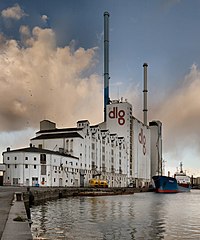Five Sisters (Aarhus)
| The Five Sisters | |
|---|---|
| DLG Silo complex | |
 |
|
| General information | |
| Location | Aarhus, Denmark |
| Completed | 1927 |
| Design and construction | |
| Architect | Hjalmar Kjær |
The Five Sisters (Danish: De fem søstre) is a building and silo complex in Aarhus, Denmark which is an Industrial Heritage Site of Denmark. It is situated on the Mellemarmen pier on the industrial section of the Port of Aarhus in Aarhus city center. The silos represent the transition from manual to mechanized labor during the second wave of industrialization in the early 20th century and is symptomatic of the relationship between agriculture, industry and transport in the city. The Five Sisters were the first reinforced concrete structure to be erected in Aarhus and at the time it was the only building apart from the cathedral to rise above the city.
In the 1800s grain was typically stored in bulk or in sacks in storehouses or merchant's attics in a process that was both labor intensive and physically demanding. The risk of the products rotting or catching fire combined with the rising amount of cargo arriving made it necessary to find a more modern solution. In the 1890s silos were increasingly used. The earliest were placed inside existing buildings but later on dedicated structures of reinforced concrete became the norm.
In 1898 the farmer's cooperative Jysk Andelsfoderstofforretning (JAF) was established and headquartered in Aarhus for the purpose of managing and selling agricultural products. The company became one of the largest in the country, opening trade hubs throughout the realm. In 1927 the silo complex was erected in the south harbor with designs by the architect Hjalmar Kjær. The new structure heralded a change in labor processes with physically demanding work being replaced by electrical engines and elevators. Initially the silos had capacity for 12000 cubic meter oilseed and 13800 cubic meter grain while the lifting systems could handle 120 metric tonnes per hour. Building the silos into one structure made it possible to aerate the grain by moving it from one silo to another with electrical cup elevators and later vacuums. The elevators was also used to load and unload cargo ships and at the same time unloading coal became mechanized with cranes. The system was the beginning of a greatly reduced labor force in the port.
The productivity benefits quickly became apparent; ships increased in size proportionally to the amount of cargo that could be handled. The Five Sisters was the first but other complexes followed shortly; Aarhus Oliefabrik built a 20.000 cubic meter silo and in 1930 Korn- og Foderstof Kompagniet completed another large silo complex. In 1969 JAF merged with a number of other companies to form Dansk Landbrugs Grovvareselskab (DLG) which still owned the silo complex in the 2010s.
...
Wikipedia
